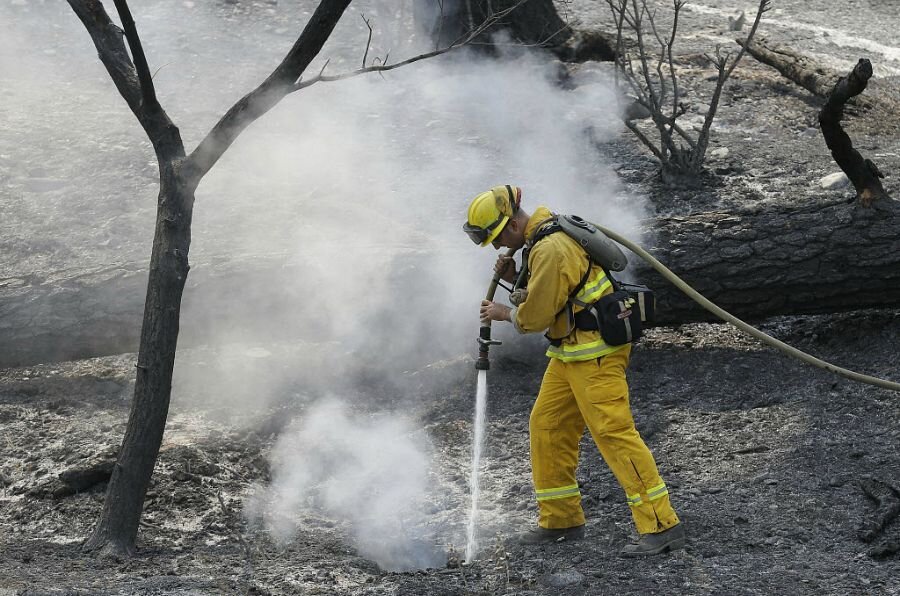Why wildfires aren't considered 'natural disasters'
Loading...
| Ashland, Ore.
What could be more “natural” than a lightning strike igniting a forest fire – the way most such fires start? In terms of cause and potential damage, isn’t it just as much a part of nature as a hurricane, tornado, flood, or earthquake?
No, at least in terms of how government agencies pay for responding to such disasters. Instead of drawing on federal emergency disaster funds, the US Forest Service must resort to “fire borrowing” – taking money from its own programs designed to help prevent such fires in the first place.
That was politically and economically tolerable when there were fewer such fires (especially in the West, where most such wildland conflagrations occur) and the budget for fire-fighting covered at least most of the cost. But in recent years, as drought conditions continued to increase – exacerbated, many experts say, by climate change – and homebuilding and other development pushed into what’s called the “wildland-urban interface,” the budgeting situation worsened.
The situation, says US Rep. Mike Simpson (R) of Idaho, “has created a devastating cycle that prevents agencies from doing needed hazardous fuels removal or timber harvests, leading to worse fires.”
Representative Simpson is the lead sponsor of the Wildfire Disaster Funding Act, a bill that would treat catastrophic wildfires like other natural disasters (floods, hurricanes, tornadoes, etc.), funding suppression of such fires through emergency disaster programs.
The nonpartisan Congressional Budget Office (CBO) reports that the bill would not increase federal spending, but it does make catastrophic wildfire suppression eligible for the disaster budget cap adjustment under the Budget Control Act, as are the Federal Emergency Management Agency (FEMA), the Small Business Administration, and other agencies dealing with natural disaster emergencies.
The bill has 124 cosponsors – Republicans and Democrats, many of them from western states. A companion bill in the Senate has 17 cosponsors.
“Wildfire seasons are getting longer and major wildfires are becoming increasingly more costly to suppress,” says Sen. Ron Wyden (D) of Oregon, lead sponsor of the Senate bill. “The Wildfire Disaster Funding Act is a critically important step to ensure the long-term health and sustainability of our nation’s forests and other public lands.”
A report this week from the US Department of Agriculture (USDA), which oversees the US Forest Service, details trends illustrating the problem.
For the first time in its 110-year history, the Forest Service is spending more than 50 percent of its budget fighting wildfires.
“Today, fire seasons are 78 days longer than in the 1970s,” the report states. “Since 2000, at least 10 states have had their largest fires on record. Increasing development near forest boundaries also drives up costs, as more than 46 million homes and more than 70,000 communities are at risk from wildfire in the United States.”
According to one study, some 60 percent of all new homes built in the United States since 1990 are in or at the edge of forestlands.
"These factors are causing the cost of fighting fires to rise every year, and there is no end in sight," Forest Service Chief Tom Tidwell said in releasing the report Wednesday.
In 1995, wildland fire costs took 16 percent of the Forest Service budget. For 2015, fire-fighting costs will take 52 percent of the budget, a figure projected to rise to 67 percent in 2025. As a result, between 1998 and 2015, Forest Service fire staffing rose from 5,700 employees to 12,000 employees. At the same time, staffing for other forest management work (recreation, timber harvesting, road building and removal, wildlife habitat, stream quality and other water issues) on the 193 million acres the Forest Service oversees has been cut from 18,000 to 11,000 employees.
Meanwhile, this summer’s fire activity in California and other western states has been fierce.
As of Thursday, the National Interagency Fire Center (NIFC) in Boise was reporting 11 new large wildfires for a total of 43 large active fires, including 17 in California, seven in Oregon, and six in Washington State. In Ashland, Ore., the valley is choked with smoke from the Stouts Fire some 50 miles to the north. The fire has grown to nearly 20,000 acres and is just 20 percent contained
So far this year, the agency reports, there have been 37,389 fires totaling slightly more than 6 million acres. At this point last year, there had been 34,697 fires totaling 1.8 million acres. The annual average for the prior 10 years (2005 to 2014) was 47,237 fires totaling just over 4 million acres.
“Compared to the 10-year-average, 2015 is lower in number of fires, but higher in acres burned by approximately two million acres,” according to the latest NIFC figures.
Here’s the outlook for the rest of August, according to the NIFC:
“Drier than normal fuels and little forecasted relief have led to above normal significant fire potential for most of the Northwest and western portions of the Northern Rockies. Long term drought will keep significant fire potential above normal in Southern California. Alaska will see continued periodic acreage growth from established fires which will lead to overall above normal significant fire potential. Elsewhere mostly normal activity should be expected; which includes frequent significant fires and plentiful initial attack for August.”








